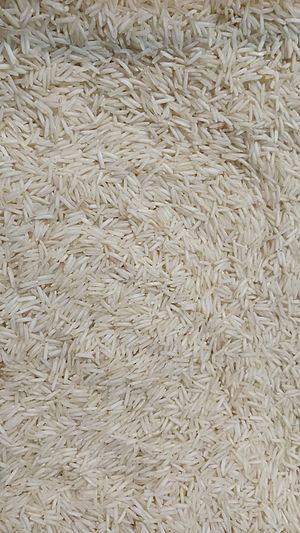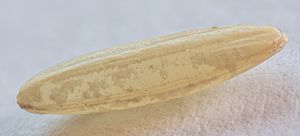Basmati facts for kids
Quick facts for kids Basmati rice |
|
|---|---|

Brown regular rice (left) compared to brown basmati rice
|
|
| Species | Oryza sativa |
| Cultivar group | Basmati |
| Cultivar | Basmati Sal, Basmati 370, etc. |
| Origin | Indian subcontinent |

Basmati is a special kind of aromatic rice with long, thin grains. It's famous for its amazing smell and taste! This rice has been grown for a very long time in the Indian subcontinent, especially in India, Pakistan, and Nepal.
Most of the basmati rice sold around the world comes from India (about 65%) and Pakistan (about 35%). Even though some countries grow their own basmati, the best and most traditional kinds come from specific areas in India and Pakistan. To be called basmati, the rice grains must be at least 6.61 millimeters long before they are cooked.
Contents
What Does "Basmati" Mean?
The Name's Meaning
The word basmati comes from the Hindi language. It means 'fragrant' or 'full of fragrance'. This name perfectly describes the rice's wonderful smell. The word is made from bās (fragrance) and -matī (a part of a word meaning 'full of').
A Long History
People believe that basmati rice has been grown in the Indian subcontinent for hundreds of years. One of the earliest times basmati rice was mentioned was in a famous poem called "Heer Ranjha." This poem was written by a Punjabi poet named Varis Shah in 1766.
Where Basmati Rice is Grown
India grows over 70% of the world's basmati rice. A small part of this is grown using organic methods. This means it's grown without man-made chemicals. Groups like Kheti Virasat Mission are working to grow more organic basmati rice in the Punjab region of India.
In India
Certain areas in India are officially known for growing basmati rice. These areas include parts of Punjab, Haryana, Himachal Pradesh, Delhi, Uttarakhand, Western Uttar Pradesh, and Jammu and Kashmir. In one year (2011-2012), India produced five million tonnes of basmati. India also sent 4.4 million metric tons of basmati rice to other countries between April 2018 and March 2019. Countries like Saudi Arabia, Iran, and UAE buy a lot of basmati rice from India.
In Pakistan
Pakistan's main basmati growing area is in the Kalar bowl. This area is between the Ravi and Chenab rivers. Almost all basmati in Pakistan is grown in the Punjab province. In 2010, Pakistan produced 2.47 million tonnes of basmati. In 2020, Pakistan sent 890,207 tonnes of basmati rice to other countries. Europe buys about 40% of Pakistan's basmati, with the rest going to countries in the Gulf, Australia, and the US.
In Other Countries
- Indonesia: Farmers in Indonesia have started growing their own type of basmati rice. They grow it in West Java and Central Kalimantan. They first tried to grow seeds from Pakistan in 2007, but the soil wasn't quite right. Later, in 2017, the Ministry of Agriculture created a hybrid rice. This rice mixes basmati with local rice.
- Nepal: Basmati rice is mostly grown in the Terai region of Nepal. It's also grown in some parts of Kathmandu valley.
- Sri Lanka: Small amounts of basmati, especially red basmati rice, are grown in the wet areas of Sri Lanka.
Smell and Taste of Basmati
Basmati rice has a special smell. Many people say it smells like the pandan leaf. This unique smell comes from a natural chemical called 2-acetyl-1-pyrroline. Basmati grains have about 12 times more of this chemical than other types of rice. This gives it its strong, special smell and flavor. You can also find this natural smell in cheese, fruits, and other grains.
When you cook basmati rice, some of this smell can fade. If you soak the rice for 30 minutes before cooking, it cooks faster. It also keeps more of its wonderful aroma.
Basmati and Your Health
The Canadian Diabetes Association says that basmati rice has a medium glycemic index. The glycemic index tells you how quickly a food makes your blood sugar rise. Basmati rice is in the middle range (between 56 and 69). This is lower than some other types of rice. For example, jasmine or instant white rice have a glycemic index of 89. This makes basmati a better choice for people with diabetes compared to some other grains.
Types of Basmati Rice
There are many different kinds of basmati rice.
Traditional and New Types
- Indian types: Some traditional Indian basmati types include Basmati 370, Basmati 385, and Basmati Ranbirsinghpura (R.S.Pura). Newer types like 1121 and Muradabadi 6465 Extra Long Grain Rice are also popular.
- Pakistani types: Pakistani varieties include PK 385, Super Kernel Basmati Rice, and D-98.
Scientists in India have also created new types of basmati. They use traditional plant breeding methods. For example, Pusa Basmati-1 (PB1) is a hybrid. It grows shorter but still has the good qualities of traditional basmati. These qualities include long grains and a nice smell. It can also produce twice as much rice as older types.
Officially Approved Varieties
Many specific types of basmati rice are officially approved.
- Indian varieties: Basmati, P3 Punjab, Type III Uttar Pradesh, HBC-19 Safidon, 386 Haryana, Kasturi, Mahi Suganda, Pusa 1121, Pusa 1718, Pusa 1509, Pusa 1692, Pusa 1637, Pusa 1401.
- Pakistani varieties: Basmati 370 (Pak Basmati), Super Basmati (Best Aroma), Basmati Pak (Kernal), 386 or 1121 basmati rice, Basmati 385, Basmati 515, Basmati 2000, Basmati 198, and Chanab Basmati.
Similar Rice Varieties Around the World
Some other countries have developed rice varieties that are similar to basmati:
- Indonesia: A basmati-like rice called baroma (aromatic basmati) was launched in Indonesia in 2019. It can grow in lower areas and is popular with many people.
- United States: A basmati-based rice called Texmati is grown in Texas.
- Kenya: A rice variety called Pishori or Pisori is grown in the Mwea region. The name Pishori comes from Peshawari. This is where basmati rice used to be sent from to East Africa.
Making Sure Basmati is Real
It can be hard to tell real basmati from other types of rice. Basmati is often more expensive. Because of this, some dishonest sellers might mix cheaper rice with basmati. In Britain, a study in 2005 found that about half of the basmati rice sold was mixed with other kinds of long-grain rice.
To fight this, scientists use special DNA tests. These tests are like DNA fingerprinting. They check if basmati rice is pure. These tests can find out if even a small amount of cheaper rice has been mixed in. Companies that send basmati rice to other countries often use these DNA tests. This helps them get purity certificates for their rice.
A Patent Story
In 1997, an American company called RiceTec was given a special right called a "patent." This patent was for certain types of basmati-like rice they had developed. This caused a lot of anger around the world. Some people called it "biopiracy." This meant taking something natural and trying to own it. It even caused a short problem between India and the United States.
However, RiceTec later lost or gave up most of the claims in their patent. Most importantly, they lost the right to call their rice products "basmati." In 2001, they were given a more limited patent. This patent was only for three specific types of rice they had developed themselves.
Images for kids
See also
 In Spanish: Basmati para niños
In Spanish: Basmati para niños







